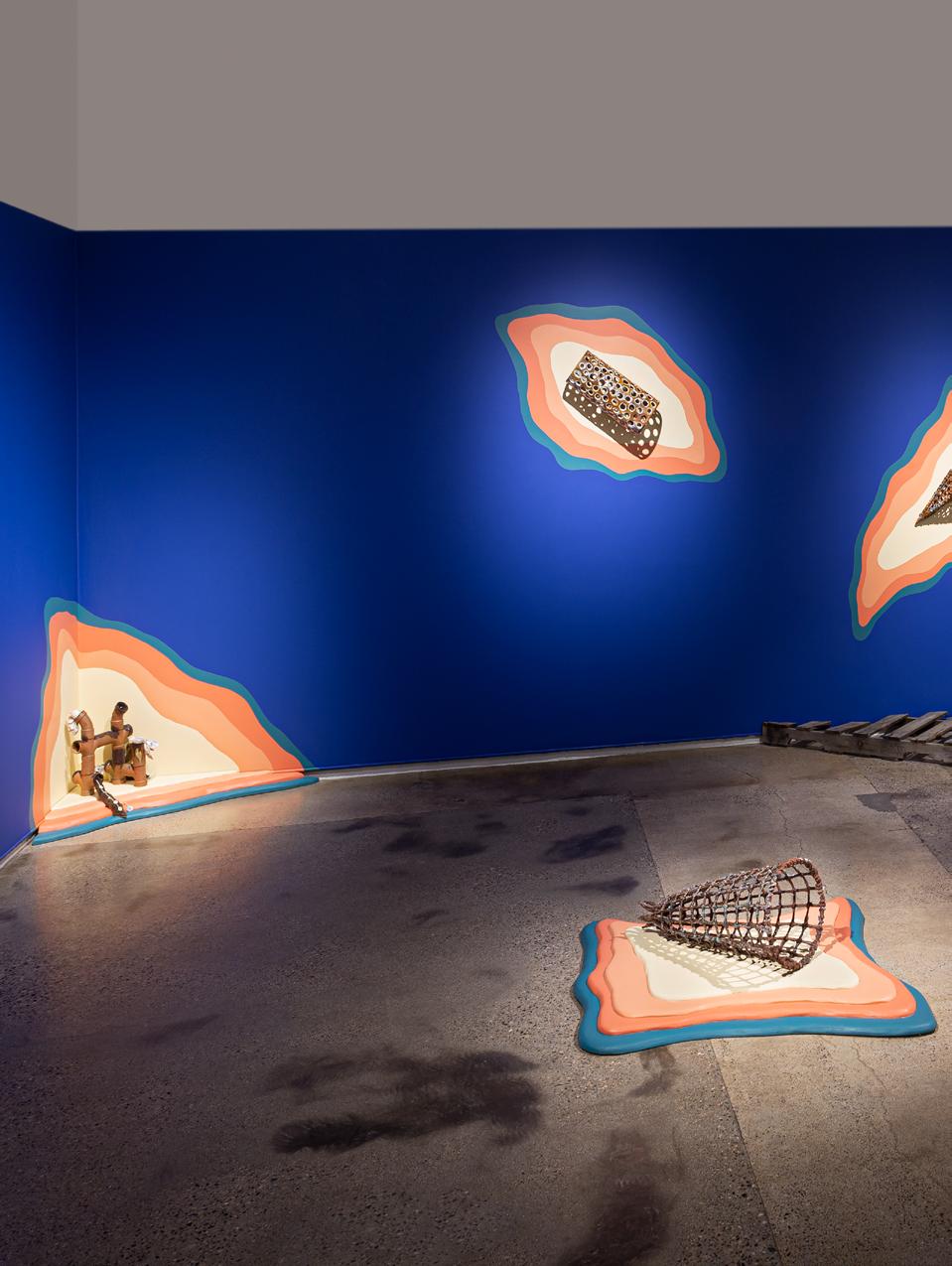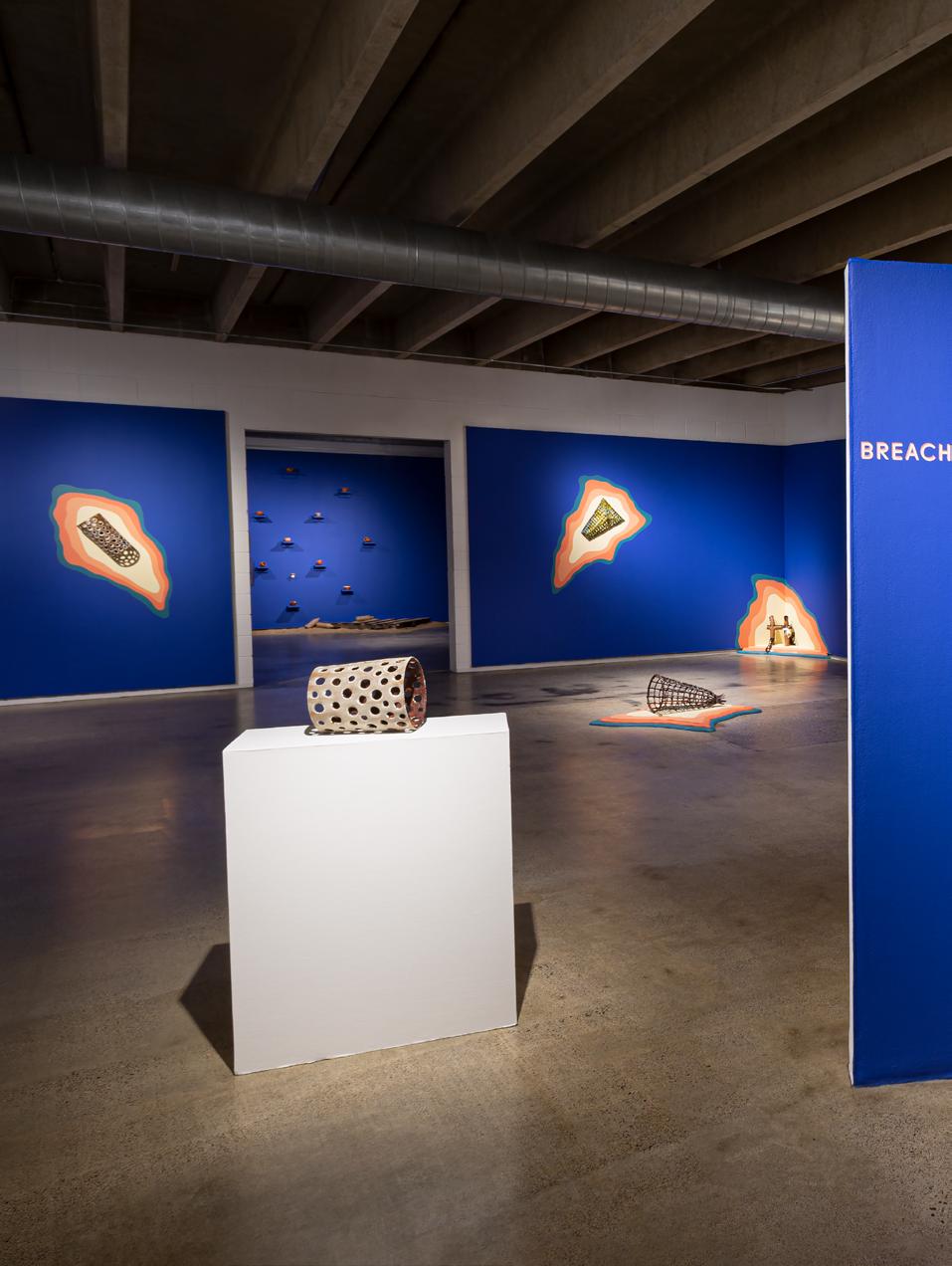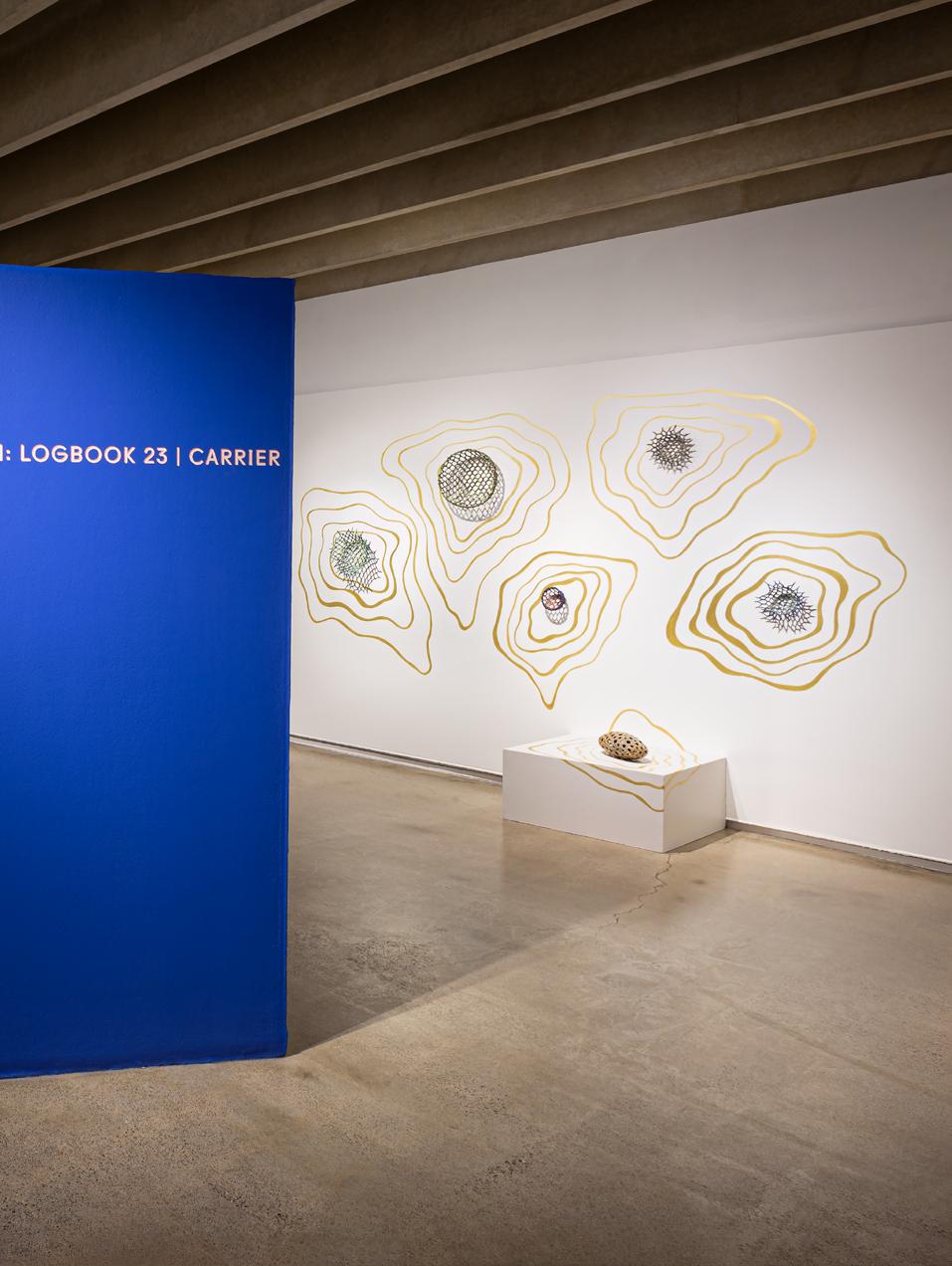BREACH
LOGBOOK 23 | CARRIER
COURTNEY M. LEONARD, CURATOR AND ESSAYIST
Courtney M. Leonard’s BREACH installation series is an annual visual logbook that explores and documents environmental impact and disparate human consequences of the relationship with water through the many definitions of the word BREACH. What comes to mind when you think about the word breach?
With multiple meanings of the word breach, there are several access points to the work in this exhibition, and the artist encourages viewers to navigate and connect with the work in their own intuitive way.
BREACH: LOGBOOK 23 | CARRIER, sets forth to create a space of connection and invitation—a shared space of remembering and learning about our collective responsibility to place and interspecies dependence.
Artist and curator Courtney M. Leonard is a Shinnecock artist and filmmaker whose work explores marine biology, Indigenous food sovereignty, migration, and human environmental impact. Leonard shares that Shinnecock translates to “people of the shore.” The Shinnecock Nation are an Indigenous coastal Tribal Nation from what is now called Long Island in New York. Leonard’s current projects articulate the multiple definitions of the term breach and investigate and document Indigenous communities’ historical ties to water, marine life, and native cultures of subsistence.
As an enrolled citizen of the Shinnecock Nation and growing up in this coastal community, she observed the effects of human impact on the coasts and, through her work in the BREACH series,
has sought to bring awareness to and advocate for these coastal areas and the layers of meaning that Shinnecock have to them. The first iteration of BREACH began when Leonard fashioned Sperm Whale teeth while reflecting on the question, “Can a culture sustain itself if they no longer have access to the environment that first supported them?” Whales are vital to the Shinnecock Nation; they are subsistence and kin, an embodiment of reciprocity.
She shared the story of her first encounter with a whale in the early 2000s when a whale had washed up on shore near the Shinnecock territory and how her Nation was not allowed to harvest or touch any part of the whale due to whales being federally protected; meanwhile, her nation, the Shinnecock, was not federally recognized (the Shinnecock Nation received federal recognition in 2010 after a more than 30-year effort). In an effort to still connect with the whale, Leonard sat on the shore with clay and coiled whale tails.
BREACH: LOGBOOK 23 | CARRIER 05
Navigating the Exhibition:
ABUNDANCE | Environmental Fragility
The ABUNDANCE Series included within BREACH: LOGBOOK 23 | CARRIER explores the human relationship with vessels or carriers while also being vessels or carriers. This work began for the artist in 2016, as she sought to explore water issues facing Long Island, which included an increase in toxic algae blooms due to excessive nutrient overload from runoff in local waterways linked to human waste and an increasingly dense population on the island.
Fish baskets are often created with the intention of filling one’s basket with fish while harvesting along the shorelines of water communities and the hope that the fish will be there. In this fashion, the creation and use of baskets are typically symbols of abundance. These baskets, the series of ABUNDANCE, are hand woven with clay coils to reference the current state of environmental fragility and the process and practice of weaving the form of a basket with the material of ceramics. The baskets within a system where collapsing planetary health and mass fish dies occur can never be filled with fish, nor can the vessels of carriers of woven coils be asked to hold the physical weight of this action if brought to task.
Pillars in this body of work reference erosion of foundations and pipes—a mark of Leonard’s research that explores the historical uses of clay drainage pipes and their replacement to the current societal piping infrastructure created from PVC and metals to both carry and divert natural water resources and human waste. The series reflects on societal changes indicated by decisions to change pipe source materials from clay pipes, that would break down over time and eventually return to the earth, to new PVC piping that, while lasting longer, can also leach microplastics. The artist returns these PVC pipes to clay once more to question both the offset and the responsibility of these anthropogenic decisions.
As a part of navigating within the exhibition space, the platforms or land formations and hand-painted line work around the objects are a reference to the practice of charting and mapping. Oyster
shells that nestle amongst the landscape of the exhibition were carried to the space having been hand harvested from the Montauk area. Oysters take seven years to mature for harvesting and consumption. Oysters are natural filters and can improve water quality. Efforts on Long Island have been made to implement colonies of oysters in an attempt to reverse the damage that over-harvesting, neglect, and pollution have caused.
CARRIER | Minnesota Waters
Leonard, a newer and still learning Minnesota resident, honors the practice of connection in a new Indigenous community and the humility and respect necessary to build trust. The stories of river/water relationships illuminated through her work in BREACH spring from observation and research but also incorporate the contributions of many and require collaboration and assent. She endeavors to offer the culturally and historically significant stories surrounding Minnesota’s waterways and their layers of meaning to local Indigenous communities. There is another reference in this area to clay pipes. These pipes have been slipcast from PVC pipes and are filled with mink furs and shells referencing the fur trade that took place in waterways in what is now Minnesota, including the Mississippi River, Minnesota River, and the Great Lakes. The current mink population in Minnesota has been dramatically affected in the last several years due to outbreaks of COVID-19 in mink populations and 3M poly-fluoroalkyl pollution that made its way to our drinking water and natural areas, to fish, and eventually accumulating in wildlife, including mink.
Leonard’s work in this study embraces the culture of atmospheric firing, specifically soda firing, and finds connections between salt- and soda-fired pipes and the single-fired pipes created during the introduction of infrastructure in Minnesota. There is also a connection to the log boom in Leonard’s wall-mounted soda-fired pillars. Early logging in Minnesota relied on the extraction of an abundance of timber, the use of nearby river systems, and the free-flowing water for transportation. This early industry attracted European settlers to Minnesota, often leading to illegal Land takings from Indigenous Peoples so resources could
NORTHERN CLAY CENTER 06
be accessed and exploited for settler expansion and profit.
During a rare drawdown of the Mississippi River in the fall of 2020, where the river was 12 feet lower than normal and revealed what the river looked like before the locks and dams were built, Leonard visited the river with her family. Leonard shared about her experience and how she could smell something she wasn’t expecting to smell in this part of the country—she was smelling freshwater mussels and learned for the first time about their presence in this area; their smell reminded her of home.
CARRIERS | COMMUNITY
Part of Leonard’s process of building connections and relationships with Indigenous communities in Minnesota is reflected in this room. Having been carried to “Minnesota,” Leonard resides in Dakota territory, growing an understanding to Mni Sota Makoce, which translates from Dakota to “land where the waters reflect the clouds.”
CARRIERS | COMMUNITY features vessels created by community members as an offering. Leonard, along with NCC, collaborated with local organizations that serve Indigenous youth through educational, social, economic, and cultural development programs, including Anishinabe Academy, Dream of Wild Health, and MIGIZI. While reflecting on memories and connections to water, each participant made a pinch pot to keep and one to be part of the exhibition. A meaningful component of the interaction in the gallery is the knowledge that, while creating the vessel, the maker understands it is ultimately an offering to another person in the community.
CARRIERS | COMMUNITY also includes a film by local artist Sequoia Hauck. Hauck is a queer multidisciplinary artist in the Twin Cities focused on creating theater, film, poetry, and performance art that decolonizes the art-making process. They have seen firsthand how art has the ability to inspire, connect, and build a sense of community. They make art surrounding the narratives of continuation and resiliency among their communities. In this film, Hauck explores stories and the meaning of the relationship of water and place
to Indigenous communities, local and beyond. Their voices are carried within the exhibition space as the film’s title encompasses the energy and intention of the space—“Let the Water Speak”.
BREACH: LOGBOOK 23 | CARRIER 07

NORTHERN CLAY CENTER 08

BREACH: LOGBOOK 23 | CARRIER 09
BREACH:
23
CARRIER
Main Gallery Installation View 2
LOGBOOK
|
ISO TRAP STUDY - YSI, 2023, Ceramics, coiled and woven earthenware, 25 x 13 x 5
Contour Elevation Color
Field Study #1, 2023, Multiply birch wood, acrylic, 45 x 51 x 5.5
BURDEN STUDY #2 Large Burden Study Fish Trap, 2023, Ceramics, coiled and woven earthenware, 13 x 13 x 26

Contour Elevation Color
Field Study #1, 2023, Multiply birch wood, acrylic, 47 x 29 x 5.5
NORTHERN CLAY CENTER 10
INTERMODAL STUDY #1, 2023, Ceramics, slipcast red clay, mink fur, Virginia oysters, shell and plastic buttons and beads, 19 x 15 x 16
ARTIFICE - CL1, 2023, Ceramics, coiled soda-fired stoneware, 18 x 8 x 8
GHOST TRAP STUDY - LTS PI, 2023, Ceramics, coiled and woven earthenware, 25.5 x 9.5 x 15

BREACH: LOGBOOK 23 | CARRIER 11
ABUNDANCE Green Sea Bloom, 2018, Ceramics, coiled and woven earthenware, 15 x 14 x 5

ABUNDANCE Red Green Algae, 2018, Ceramics, coiled and woven earthenware, 15 x 15 x 4.5
ABUNDANCE Red Blue Tide, 2018, Ceramics, coiled and woven earthenware, 6 x 5 x 3.5
NORTHERN CLAY CENTER 12
ARTIFICE Ellipse Study #1 Amber Tide, 2021, Ceramics, coiled soda-fired stoneware, 6 x 14.5 x 7.5

ABUNDANCE, 2018, Ceramics, coiled and woven earthenware, 9 x 9 x 3.5
ABUNDANCE Blue Heron, 2018, Ceramics, coiled and woven earthenware, 9 x 9 x 3.5
BREACH: LOGBOOK 23 | CARRIER 13

NORTHERN CLAY CENTER 14

BREACH: LOGBOOK 23 | CARRIER 15
Galusha Gallery Installation View CARRIERS | COMMUNITY
NORTHERN CLAY CENTER
Northern Clay Center’s mission is to advance the ceramic arts for artists, learners, and the community, through education, exhibitions, and artist services. Its goals are to create and promote high-quality, relevant, and participatory ceramic arts educational experiences; cultivate and challenge ceramic arts audiences through extraordinary exhibitions and programming; support ceramic artists in the expansion of their artistic and professional skills; embrace makers from diverse cultures and experiences in order to create a more inclusive clay community; and excel as a non-profit arts organization.
Northern Clay Center would like to offer thanks to our community partners for their contributions to CARRIERS | COMMUNITY, their engagement, and their trust.
Anishinabe Academy
• Anishinabe Academy is dedicated to serving and educating the families of Minneapolis through a Native lens, with a Native-centered curriculum, and through Dakota and Ojibwe language, now taught in all grades.
• With support from Siena Braun, the school’s Native Culture Arts Specialist, 100 fourth and fifth grade students worked with Courtney M. Leonard, Priya Thoresen, and Abigail Cooper.
Dream of Wild Health
• Dream of Wild Health’s mission is to restore health and well-being in the Native community by recovering knowledge of, and access to, healthy Indigenous foods, medicines, and lifeways.
• Youth Leaders and staff participated in a hands-on clay session at NCC taught by Courtney M. Leonard, Priya Thoresen, and Samantha Gonzalez Longley.
MIGIZI
• MIGIZI (which means “bald eagle” in the Ojibwe language) upholds its mission to provide a strong circle of support that nurtures the educational, social, economic, and cultural development of American Indian youth.
• Their CLAW program—Culture, Leadership, Academics and Wellbeing—visited NCC to view the exhibition and to create their own clay vessels in a workshop led by Abigail Cooper.
Exhibition Staff
Kyle Rudy-Kohlhepp, Executive Director
Tippy Maurant, Deputy Director/ Director of Galleries & Exhibitions
Maria Hennen, Galleries Coordinator
Additional Staff instrumental in the production of BREACH and its impact in the community
Samantha Gonzalez Longley
Sean Lofton
Sarah Millfelt
Katie Reeves
Board of Directors
Paul Vahle, Board Chair
Amanda Kay Anderson
Bryan Anderson
Heather Nameth Bren
Evelyn Weil Browne
Nettie Colón
Sydney Crowder
Haweya Farah
Patrick Kennedy
Mark Lellman
Kate Maury
Brad Meier
Philip Mische
Debbie Schumer
Rick Scott
Cristin McKnight Sethi
Honorary Directors
Kay Erickson
Legacy Directors
Andy Boss
Warren MacKenzie
Joan Mondale
Curator and essayist: Courtney M. Leonard
Photographer: Peter Lee Design by Joseph D.R. OLeary (vetodesign.com)
NORTHERN CLAY CENTER 16
2424 Franklin Avenue East Minneapolis, Minnesota 55406 612.339.8007 www.northernclaycenter.org










